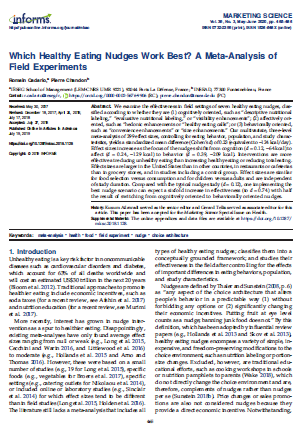Abstract
We examine the effectiveness in field settings of seven healthy eating nudges, classified according to whether they are (1) cognitively oriented, such as “descriptive nutritional labeling,” “evaluative nutritional labeling,” or “visibility enhancements”; (2) affectively oriented, such as “hedonic enhancements or “healthy eating calls”; or (3) behaviorally oriented, such as “convenience enhancements” or “size enhancements.” Our multivariate, three-level meta-analysis of 299 effect sizes, controlling for eating behavior, population, and study characteristics, yields a standardizedmean difference (Cohen’s d) of 0.23 (equivalent to −124 kcal/day).
Effect sizes increase as the focus of the nudges shifts from cognition (d = 0.12, −64 kcal) to affect (d = 0.24, −129 kcal) to behavior (d = 0.39, −209 kcal). Interventions are more effective at reducing unhealthy eating than increasing healthy eating or reducing total eating. Effect sizes are larger in the United States than in other countries, in restaurants or cafeterias than in grocery stores, and in studies including a control group. Effect sizes are similar for food selection versus consumption and for children versus adults and are independent of study duration. Compared with the typical nudge study (d = 0.12), one implementing the best nudge scenario can expect a sixfold increase in effectiveness (to d = 0.74) with half the result of switching from cognitively oriented to behaviorally oriented nudges.
